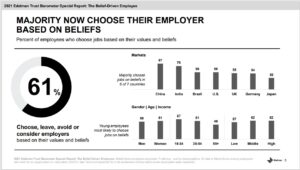Building an essential collaboration between comms and workplace wellness
When employees hear a consistent message in a consistent voice, they get a clear idea of the values of the company and how it is prioritizing the good health.

Workplace well-being exists at the intersection of the wellness discipline and its peer departments, including HR, benefits and communications. Wellness and comms in particular have forged a collaboration to support their employees as workforces everywhere face an array of ongoing challenges. In this Q&A, Michelle L. Artibee, director of workforce wellbeing at Cornell University, and Michael Waterman, vice president, communications and learning & development at CHG Healthcare, preview the themes of their upcoming session at Ragan’s Workplace Wellness Conference, coming on Wednesday. Register for the virtual event today, and use the code TONY to get a $150 discount.

Workplace Wellness Insider: What are the critical elements of a comprehensive collaboration between comms and workplace wellness pros?
Michelle Artibee: Understanding of what each group does and what their strengths are—break down assumptions (well-being folks often think comms folks remove all emotion from messaging to the detriment of the message. Comms folks often think well-being folks have no idea how limited people’s attention span is and the importance of being concise.
Michael Waterman: So true! It’s easy to view each other from our own lens of expertise and underestimate the value and knowledge our respective partners bring to the challenge we’re trying to solve.
Artibee: Clarity on roles and when collaboration is actually necessary (how can wellbeing experts be trained/equipped to do communication basics and when are comms experts needed)
Waterman: Good point. We’re working with our wellness partners to find ways they can effectively “self-serve” on projects when our time and resources are limited. There are some risks in the “self-serve” approach. The most obvious and likely are issues with formatting in message templates and typos in copy that will be jarring to the communications pro but not so obvious to most people who read the message. We’ve spent time helping our wellness partners navigate their way around our email templates and, in cases where they are self-producing and delivering the message, always suggest a second set of eyes reads any message before it goes out to the company. In most cases, messages are shared without issue. But it’s worth addressing these challenges and risks in advance so they don’t appear as a surprise when they inevitably happen.
Artibee: Messaging that can be customized to various areas of an organization (how we communicate with our facilities employees will differ from faculty). Other elements including arming the messenger, a shared commitment to storytelling, mutual agreements on how to maintain a strong collaboration, and determining what data is being used, or could be used, to inform the success of these efforts.

WW: What practical impediments exist in establishing and nurturing that collaborative relationship?
Artibee: There’s a “curse of knowledge” among wellbeing folks—using wellbeing jargon and at such a depth it goes over the heads of others.
Waterman: We often create a short list of terms and acronyms that help communications and wellness teams work together and speak the same language. These lists are particularly helpful when new people begin collaborating and help ensure the final messages aren’t jargon-heavy, but speak a common language we can all understand (while defining terms as needed in the content).
Artibee: There is a mixed bag of comms understanding of the complex human issues well-being folks deal with regularly (e.g. mental health).
Waterman: This is a good example of why partnership is critical to ongoing success. Communications people can easily miss the nuances of terms used to describe complex health and human issues, in the same way a wellness practitioner may miss the nuance of word choices to convey meaning. It’s why we’re better when we work together.
Artibee: There’s also a lack of long-term planning, especially in a crisis.
Waterman: This one is huge. If the wellness team can anticipate a potential change or crisis, let’s collaborate to develop messages long in advance of that change. For example, in early 2020, CHG decided we were going to make a meaningful and positive change to our health plan for 2021. In spring 2020—during the COVID crisis—we started initial discussions to explore messaging to support this new health plan. It was challenging to prioritize time and work on a future issue during a current crisis, but it ensured we were well prepared to introduce the enhanced health plan for open enrollment in fall 2020.
Artibee: Organizational crisis or top priority comms issues can make it stressful for comms teams to take on the amount of well-being messaging desired.
Waterman: It’s important that we are all aware of organizational noise. A wellness practitioner is naturally focused on the scope of their role. A communications practitioner is generally aware of the broad scope of messaging across the company each week, which can easily include messages ranging from compensation updates to news about cultural initiatives or ways to give back to the company—layered on top of a town hall meeting with the CEO and follow-up reminders from the training team. That broad awareness empowers the communications person to put guardrails on the number of messages wellness (or other business partners) should share each week to balance the total number of messages employees receive. Without that balance, we can quickly overwhelm employees with so many messages that an important wellness message gets lost in the clutter.
Artibee: There are skills challenges on both ends. Well-being is strong in humanness, and comms is concise.
WW: What outcomes can be produced by an effective collaboration?
Artibee: Impactful messaging that results in actions taken by employees.
Waterman: I agree. When we’re working together, we strike the right tone, we capture the right balance and depth of message and detail. Most important, we manage the message flow so we don’t overwhelm readers with too much information too much of the time. When we get this balance right, people are able to take actions on the good resources and information our wellness teams provide.
Artibee: And there’s increased clarity in what the employer values about employee well-being.
Waterman: Yes. When employees hear a consistent message in a consistent voice, they get a clear idea of the values of the company and how they are prioritizing the good health of its people.
WW: What other stakeholders are essential here?
Artibee: D&I, managers, front lines HR folks, Finance and Facilities.
Register for Ragan’s Workplace Wellness Conference today for this and lots more essential content about workplace wellness.






